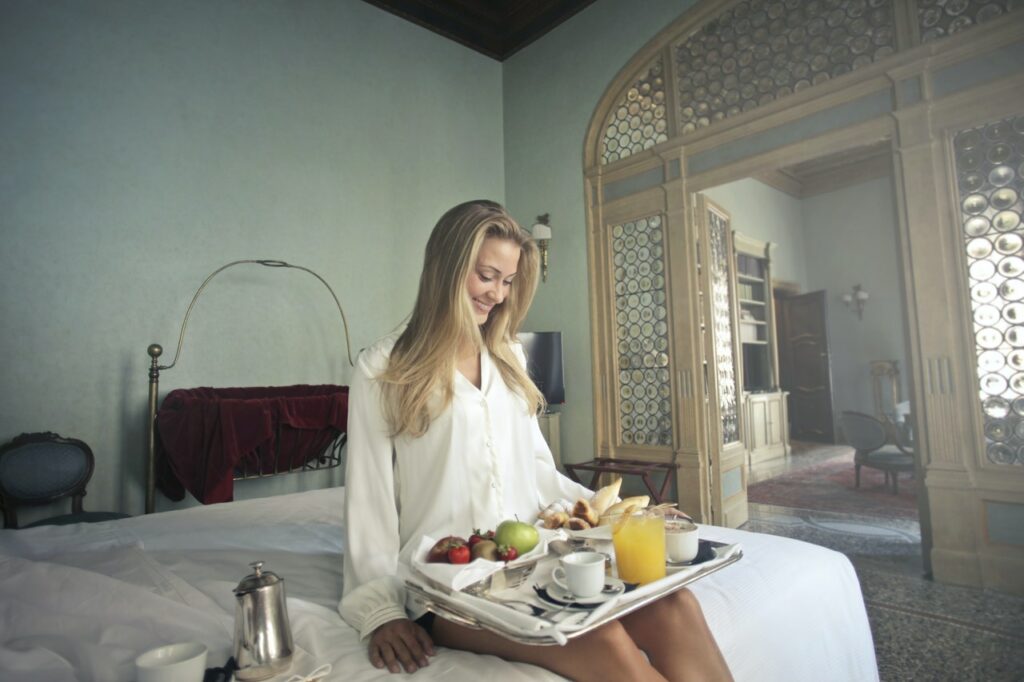
Tour personalisation – how can we collectively fix distribution to better delight customers?
February 9th, 2022
by Alex Bainbridge
Personalisation, or personalization, is key consumer need that we as an industry are really poor at digitally solving. This article outlines the current state of play and proposes a new cross-industry approach, using web3 & blockchain, that we collectively can adopt.
Personalisation matters to consumers
For our sector, personalisation is in two parts. Some examples:
- Discovery personalisation – Not suggesting a steak experience to a vegetarian (a preference), or not suggesting a visit to the Eiffel Tower, when they went to the Eiffel Tower yesterday (observed activity). Discovery takes place on online travel agent websites, apps and other offline locations
- Service personalisation – Knowing the customers travel address (e.g. their hotel or vacation rental) and finishing a tour at their hotel rather than the regular end destination
Although both parts are important, in this article my main focus is discovery personalisation as that is where we need cross-industry collaboration to make it work.
Wider personalisation trends
Before we get too deep into what personalisation means for sightseeing & experiences, lets take a quick look at wider personalisation trends from recent research:
- Destination Experience: Driven by Data, Inspired by Travelers – January 2022 – “When asked what are the biggest opportunities for the travel and tourism industry in the future, more than half the audience was looking to improve on personalization”
- Shopify Future of Commerce Trend Report 2022 – “Forty-four percent of consumers say they’re OK with brands they like using their personal information to deliver relevant content and offers”
Dana Dunne, Chief Executive of eDreams ODIGEO, writing in Travolution:
In 2022, personalisation will continue to be key in the travel industry. But what makes it so important?
It is crucial because it enables customers to save a significant amount of time – potentially taking days or weeks of trip research right down to minutes or seconds.
The fact is that customers now expect it – it’s no longer a ‘nice to have’. If you don’t offer customers a personalised experience, they will go elsewhere.
Read the full article via Travolution
So are we all agreed that personalisation is important? Great, now lets discuss why we are so terrible at delivering it and what we can do about it:
Current industry distribution/retail structure
The personalisation problem is a direct result of the current industry structure.
- From tour operators up to online travel agents we distribute fixed itineraries, dates, prices, availability
- From online travel agents down to tour operators we distribute bookings with basic customer contact details
In this structure, consumers are very secondary, with at the most their name, email address and mobile phone number the only details that an operator receives for a booking via a retailer. Furthermore, with many retailer initiated bookings the email is not a direct email address, but redirected via a proxy.
Overall, it would be hard to design an approach that would lead to a poorer capability to personalise the consumer experience
I was one of the early distribution innovators back in 2012-2015, and we didn’t start with a clean sheet of paper, so this is how we ended up. We were not designing to support personalisation at the time, we were designing to replace annual excel spreadsheets containing rates & prices.
Approach #1 – Online travel agents try to fix using an algorithm
The two best funded in the sector have given fixing the problem a go by themselves:
In 2017 Johannes Reck from GetYourGuide told TechCrunch:
“We’re trying to hone our recommendation algorithms — and we’re actually working quite a lot on machine learning and AI right now in order to really understand what customers want, to understand customer intent before they book, when they book, after they’ve booked — and then really have tailored recommendations. So that we can become a much more integral part of their trip.
“A couple of years down the line,” added Reck, “with what we’re building, with a smartphone you’ll have a companion in your pocket that you can take out at any point in time and will recommend you the best things for you to do for your trip at this very point in time.”
In 2019, Airbnb documented their machine learning approach:
The main take-away is that machine learning-based Search Ranking works at every stage, given that we pick the model and infrastructure with the right level of complexity for the amount of data available and the size of the inventory that needs to be ranked. Very complex models will not work well when trained with small amounts of data, and simple baselines are sub-optimal when large amounts of training data are available.
Their long engineering article explaining their approach is very much worth a read.
As technically brilliant as these solutions are, they are still miles away from what the consumer needs.
If a service is still suggesting a food tour that includes a steak tasting experience to a vegetarian, you are not really achieving much.
Approach #2 – Bring in the tour operators and attractions
Ok so if the online travel agents can’t fix this by themselves, perhaps adding tour operator and attraction input would help? One way to approach this could be:
- White water rafting – an activity company may operate two experiences – one for novices, one for more experienced people
- Food tours – a guide may operate two experiences – one for those new to the region, others who want a deeper dive into local food history & culture
Perhaps a retailer could enable consumers to see the range of experiences from the same supplier and be pitched, by the tour operator / attraction, which one is more appropriate for them to book. e.g. now we don’t get inexperienced rafters on the harder rivers.
I rejected this approach because this is too prescriptive to the retailer in terms of display, ranking and interlinking experiences. Retailers want to keep their existing ranking algorithms and control over how experience suggestions are interlinked.
Approach #3 – Ask the consumer what they want!
I know, radical!
Consumers are not great at stating what they want, especially when they are opening themselves up for new experiences when in tourist mode.
However what consumers do know is what they don’t want. e.g. a vegetarian will never select a food tour centred around a steak tasting experience. Or someone with limited mobility won’t take a walking tour.
So preferences based on common filtering requirements will work as preferences are designed to exclude rather than to promote. The big question is how do we get these preferences configured and shared over the industry without the customer having to answer 101 questions every time they go to a new travel or hospitality website.
I propose that web3, blockchain and self-sovereign identity solves this for us.
An MVP demo:
In this video you can see this flow:
- The preferences set in one place (Sahra.vip) (e.g. I eat fish & meat, but not dairy, in this example)
- I then transferred these preferences to a digital wallet. (I used Trinsic)
- I then went to Uptaste and with a quick wave of my phone, the Uptaste website removed inappropriate food tour suggestions using preferences held in the digital wallet. Magic. 🪄
What makes this approach so interesting is due to the open & interoperable nature of web3 / self-sovereign identity that you can use this on your website, for your existing tours, without even having to use any of our APIs or technology. Yes web3 does take a little while to get used to, conceptually!
This is all public so you can go and do exactly this yourself, if you wish to!
Sign up via Sahra.vip and give it a go (as a consumer). In particular try the discovery demo on Uptaste.
Should you use this personalisation approach?
The key decision on whether to use this, whether you are an online travel agent or a larger tour operator, is that you should not set expectations that you cannot meet. (Also a good rule for life in general!)
If you ask a customer if they are vegetarian AND you continue to show steak based food tour experiences, this is arguably worse than not asking at all. The consumer will expect you to handle their preferences.
I took a look at our demo food tours (we have 57, excluding picnics):
Out of these 57:
- 17 include dairy as a main theme
- 13 include meat
- 12 include gluten
- 11 include fish
- 3 include alcohol
e.g. we know that if you are a non-drinker and don’t eat dairy, a reasonable number of our food tours will be filtered out.
Or for mobility:
- 38 of the 57 food tours have over 1 mile of walking
- 11 visit venues that are not wheelchair accessible
i.e. you should not personalise using preferences unless you are totally on top of your corresponding product data.
Motivation
I built this so we can distribute & operate personalised experiences using autonomous vehicles.
More on this soon. Suffice to say it has been a momentous couple of months for robotaxis:
- Waymo (Google) has announced their robotaxi design
- Cruise (GM / SoftBank / Microsoft) has gone live to the public in San Francisco
- AutoX (Alibaba) announced they now have 1000 robotaxis on the streets in China
Now that Cruise is live to the public in San Francisco (with 200 robotaxis expected in 2022) we can get up and running in San Francisco with our personalised experiences…
Basic concept for robotaxi sightseeing – 2 cocktail bars, a games venue and 24 hour donuts…..! (Would not be suggested to consumers who are gluten intolerant)
Not our video but embedded here because it is of historical interest as the earliest Youtube video I can find of using robotaxis for sightseeing in San Francisco. [Likely filmed by a Cruise employee]
Image: Pexels

This content is protected by copyright. Link sharing is encouraged but duplication and redistribution is illegal


I know some love to comment via linkedin, here is the thread! https://www.linkedin.com/posts/alexbainbridge_tour-personalisation-how-can-we-collectively-activity-6897199775708516352-B6ke
Alex,
Working in this space in the 1990s, I studied what we then called “forced pair analysis.” I see that it’s now called by wikipedia, “pairwise comparisons.” Perhaps that’s what’s you’re doing, but it’s not clear from your post.
Alvin
https://en.wikipedia.org/wiki/Pairwise_comparison
Alex,
Working in this space in the 1990s, I studied what we then called “forced pair analysis” (e.g. the basis for Netflix recommendations). I see that it’s now called by wikipedia, “pairwise comparisons.” Perhaps that’s what’s you’re doing, but it’s not clear from your post.
Alvin
https://en.wikipedia.org/wiki/Pairwise_comparison
Hi Alvin, Thank you! Yeah we are definitely using preferences to remove things, rather than preferences to push things (although not exclusively so, we do have some preferences that WE have chosen to apply as ranking rather than filters). By taking this approach we leave existing retail algorithms intact – just the retailers can remove things POST their algorithm doing all their existing work……. nice name that pairwise thing!